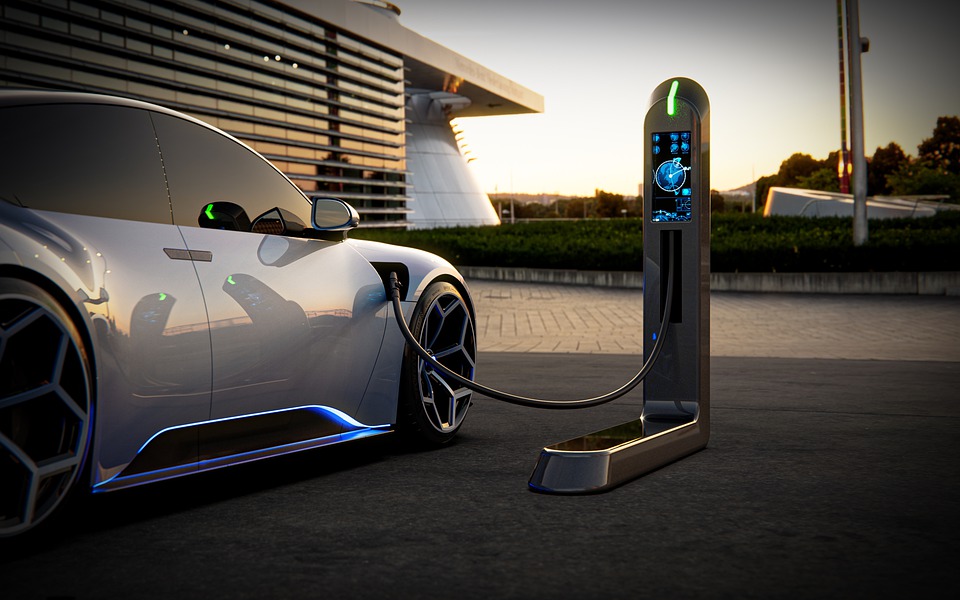Electric vehicles (EVs) are finally having their moment, thanks to the raft of electric vehicle incentives embedded in the Inflation Reduction Act (IRA). Signed into law by President Biden in August 2022, the IRA has powered up benefits for homeowners making energy improvements and for Missouri electric-vehicle (EV) drivers, business owners with amenities surrounding EV charging stations, landowners, and transportation infrastructure workers. The IRA piggybacks on President Biden’s goal of having 50% of all new-vehicle sales be electric by 2030. You can get caught up on how the IRA puts money into a homeowner’s pocket in a previous blog post in this series here. But if you’re an EV owner, transportation sector or construction worker, or even an entrepreneur, you can also reap the rewards, too.
How, you might ask? Well, we’ll tell you in this post.
And for this post, we will concentrate around REspace’s home base—the metro east region of southern Illinois and eastern Missouri St. Louis Metro East? Which is best —and zoom in on Missouri benefits in particular.
IRA’s Benefits and Challenges for Businesses & Communities
Charging Stations and Corridors
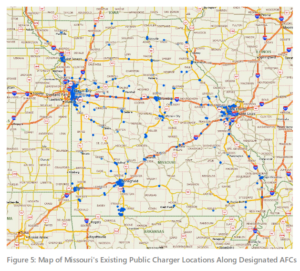
Statewide
Consumer electric vehicles (EVs) comprise a key cog of the energy-efficiency component of the IRA. So, the IRA overflows with electric-vehicle incentives. And where there are EVs, of course charging stations also need to exist. So far in Missouri, build-out for EV charging stations has been sluggish. As of September 2022, only 22 charging stations dotted Missouri’s Alternative Fuel Corridors (AFCs) and another four were still under construction, according to News Tribune. Federally designated AFCs in Missouri exist along the full lengths of Interstates 29, 35, 44, 55, and 70. The initial stages of IRA funding will be used to create either brand-new or upgraded charging stations in these AFCs. The map at right depicts the current AFCs as of late 2022. Specifically, the MoDOT plan for early funding “will fuel the development or upgrade of charging stations in eight locations: two in Kansas City and one each in Craig, St. Robert, Lamar, Butler, Concordia, and St. Joseph” (News Tribune).
A St. Louis snapshot
St. Louis, Missouri, is just one area of Missouri experiencing growth in EV charging stations and amenities for such. As you can see from this screenshot of Charge Hub, St. Louis, Missouri, and the surrounding metro east, many EV charging stations of various levels exist independent of the AFCs. The News Tribune also reports that “dozens more [exist] in various locations throughout the state.” And, where charging stations pop up, amenities are sure to follow.
Amenities
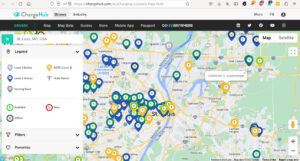
Missouri’s plan extends to partnerships among utility companies, private businesses, and local governments to flesh out the EV charging network overall. Thegeneralized location needs for the charging stations have been finalized already. However, the individual businesses or entities applying to the program to become charging hubs will need to determine their exact locations and the types of amenities surrounding them. To that end, MoDOT has made recommendations for what types of amenities should exist close to the quickest of the charging stations (approximately 10- to 30-minute charge times). The most desired services, at least to MoDOT’s planning purposes, are playgrounds, parks, and pet relief areas; restaurants and convenience stores; and back-up power connection sites. Also throw into the mix rest-stop–like 24-hour amenities including vending machines, bathrooms, lighting, benches, trash cans, and safety measures such as security cameras and lighting.
Funding
After the so-called national network of charging stations is fully built out along the interstates through programs such as the IRA, MoDOT will shift toward building EV stations in remaining gaps in the state, as well as on upgrading existing charging stations so that they comply with evolving federal standards. To that end, incentives will be offered to entice private and community investments in charging stations and infrastructure. Some incentives for communities and businesses include the following, which may or may not be continued if funding is available:
- The Charge Ahead program from Ameren Missouri: This program offered incentives to non-residential customers for the installation of Level 2 (240-volt) EV charging stations or DCFC (direct-current fast charger[s]) stations at qualifying multi-unit dwellings, workplaces, and public areas within Ameren’s service territory and which required no electrical upgrades.
- The $2.9B Environmental Mitigation Trust Fund: This funding, which is not part of the IRA, is provided through a legal settlement with Volkswagen (for its 2016 Clean Air Act violations settlement) and will be used to support zero-emission vehicles, or ZEVs. Missouri’s portion of that total amounts to just over $41M, which will be allotted to specific projects before October 2027. This includes $12M for newer school buses or bus engines, $6M for “large and medium nongovernment-owned trucks with 1992 to 2009 engine,” and $6M for EV charging stations that “can be built for light-duty vehicles near highways, workplaces, or multi-unit dwelling.”
Range Anxiety
Although the IRA plots a variety of electric vehicle incentives, it is important to note that there are some limitations. One is drivers’ range anxiety about the distances they can safely drive in said vehicles.
A plan submitted July 29, 2022, by the Missouri Department of Transportation (MoDOT) aims to reduce the driving distance between each charging station to less than 50 miles, which will fight EV drivers’ range anxiety. As of this writing, the federal government Joint Office of Energy and Transportation has received and is still reviewing MoDOT’s plan submitted in September 2022; this review process (if the plan is approved) is required for the state to receive funding from the National Electric Vehicle Infrastructure (NEVI) Formula Program. That $5B (countrywide funding) formula program is part of the 2021 Bipartisan Infrastructure Law passed by Congress, which divvies up $98.9 million to Missouri in the next half-decade to get EV charging infrastructure in place.
To read the full version of this NEVI program—all 50-plus pages of it—go to this pdf.
[Side note: As of this writing, Missouri consumers can submit survey responses regarding the potential locations and amenities of EV charging stations, including where to distribute faster chargers and slower chargers around the state, here, in a NEVI Formula survey.]
Missouri also has an Electric Vehicle Task Force, which was created by the state legislature to address infrastructure deficiencies with regard to EVs. That task force met during the Fall/Winter 2022, releasing its report of recommendations in December 2022. The recommendations include further study of how to recycle the EV batteries carried out by Missouri’s Department of Natural Resources and more planning into how to implement EV “fuel” taxes per kilowatt hour and a EV decal program. That (also massive, but data-chocked) “final report,” weighing in at 253 pages, is available via Missouri’s Department of Revenue here. Some items in the report dovetail with NEVI, such as recommendations on how to incentivize decals for EVs, which will be discussed in the “IRA’s Benefits for EV Owners” section.
MoDOT will begin reviewing proposals for the first round of federal funding in 2024, according to the submitted plan. Funding will be awarded and charging station construction can begin as early as 2025.
Owners’ Electric Vehicle Incentives in Missouri
EV Charging Station Rebates
According to the MoDNR report mentioned earlier, the “sustainable” utility company Evergy will be offering a $500 rebate for the purchase and installation of a Level 2 (240-volt) EV charging station to qualified residential customers who either purchase or lease an EV and who enroll in a time-of-use rate program via Evergy’s EV Charging Rebate website. As of this writing, however, Evergy is available only in the area surrounding Kansas City, Missouri, over to Wichita, Kansas.
Individual Electric Vehicle Incentives
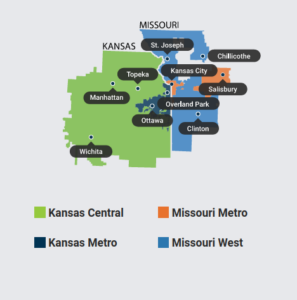
Two other pertinent incentive programs may be relevant to EV owners in Missouri.
- The alternative fuel vehicle (AFV) decal program: Missouri’s state motor fuel tax does not apply to vehicles that are
- powered by an alternative fuel, including electricity, if the vehicles obtain an AFV decal. The AFV fee structure is by type of vehicle and Gross Vehicle Weight (GVW). The decal fee for plug-in hybrid electric vehicles model year 2018 and later is discounted—at only half of the annual decal fee applied to other AFV types. Although the fees for other AFV vehicles are generally modest at around $75 to $1,000 (for the heaviest vehicles) depending on type/weight, this small discount is nice to have.
- AFV Emissions Inspection Exemption: According to the MoDNR report, “Vehicles powered exclusively by electricity, including low-speed vehicles, hydrogen, or fuels other than gasoline that are exempt from motor vehicle emissions inspection under federal regulation, are [also] exempt from state emissions inspection requirements [in Missouri].”
EV Tax Credits
New EVs
The electric vehicle incentives for Missouri extend to both new and used EVs. Specifically, the IRA amended the Qualified Plug-in Electric Drive Motor Vehicle Credit, also known as the Clean Vehicle Credit, and added a new requirement for final assembly in North America that took effect on August 17, 2022. In short, the IRA “extends and tweaks an existing tax credit—worth up to $7,500—to individuals who buy new ‘clean’ vehicles like electric cars, plug-in hybrids, and hydrogen fuel cell vehicles. The credit would be available through 2032.
There are limits to and requirements for the new-EV credits, however.
- Vehicle price limits: Trucks, SUVs, and vans must be under $80,000. For other vehicles, $55,000 is the sticker-price limit.
- Vehicle manufacturing/assembly conditions: The car must undergo final assembly in North America and be made by a qualified manufacturer, plus meet qualifications regarding the sourcing of battery and other vehicle components, such as “critical mineral and battery component requirements,” as listed under the IRS’ “Credits for New Clean Vehicles Purchased in 2023 or After.” For new vehicles purchased from qualified sellers and placed into service after April 18, 2023, an EV buyer will receive the entire $7,500 only if the vehicle meets BOTH the critical minerals requirement AND the battery components requirement; otherwise, if one or the other is met, the incentive is $3,750.
- Sales caps: Many 2023 vehicles have hit the 200,000 EV unit caps, such as the affordably priced Chevy Bolt EUV and EV (2023). The government provides a VIN search tool to identify qualifying North America–produced EVs, including early model 2023s.
- Income limits: The IRS notes some income limitations to the EV tax credits, too. Most notably, for EV owners to get the credit, “your modified adjusted gross income (AGI) may not exceed $300,000 for married couples filing jointly; $225,000 for heads of households; or $150,000 for all other filers.”
- Capacity/weight limits: The vehicle must have a battery capacity of at least 7 kilowatt-hours (kWh), plus have a GVW of under 14,000 pounds.
Used EVs
Interestingly, the IRA also allows for a tax credit for used versions of clean vehicles or EVs. Buyers could receive a $4,000 credit or 30% of the sale price, whichever is less. There are more income, vehicle, and sale limits to this category, too. You can find them spelled out in the article here
In the Works: Other EV Incentives in Missouri
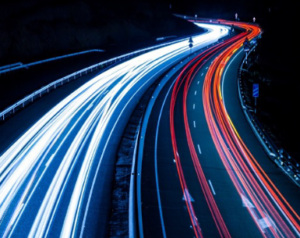 According to a Biden administration Fact Sheet, “Because of President Biden’s leadership and historic investments, electric vehicle sales have tripled and the number of publicly available charging ports has grown by over 40% since he took office. There are now more than 3 million EVs on the road and over 135,000 public EV chargers across the country.”
According to a Biden administration Fact Sheet, “Because of President Biden’s leadership and historic investments, electric vehicle sales have tripled and the number of publicly available charging ports has grown by over 40% since he took office. There are now more than 3 million EVs on the road and over 135,000 public EV chargers across the country.”
These numbers will only continue to grow as the IRA and its like spawns additional programs. For instance, the overall “EV Acceleration Challenge,” is a call to action for stakeholders in the public and private spheres to ramp up EV production in a major way. The challenge targets four major areas of improvement: tools and resources, consumer education and support, community charging efforts, and EV fleet expansion.
One example of an IRA-adjacent initiative (that also dovetails nicely with the IRA’s funding mechanisms) with regard to fleet expansion is Uber’s goal (via the Green Future program) to reach 400 million EV miles driven on its platform in the U.S. by the end of 2023. And yet another is Zipcar’s commitment to allocating 25% of its EVs to so-named disadvantaged communities in 2023 alone. Other companies are pitching in with respect to fleet expansion as well. You can read more about them at the White House’s fact sheet here.
In terms of the community charging efforts that could ultimately benefit EV drivers down the pike, there’s a range of programs from great to small:
- The National EV Charging Initiative: A group of government, business, labor, and nonprofits organized by the Natural Resources Defense Council launched its Energize! campaign in May 2023, “to stretch federal funding for EV charging further by securing complementary state, utility, and private investments and policies that also speed the energization of charging stations for cars, trucks, and buses.”
- Beginning in June 2023, the Electric Power Research Institute (EPRI) will inaugurate “EVs2Scale2030,” a three-year plan “to mobilize 500 industry stakeholders, including utilities, vehicle manufacturers, fleet operators, and charging providers, to ready the grid and accelerate the charging infrastructure needed to support the large-scale electrification of transportation.” EPRI’s 2-pager explaining EVs2Scale2030, and which encourages electrical utilities to prepare for large-scale adoption of EVs, is available as a pdf here.
- And, starting on the smaller scale, itselectric has a goal to “install 100 curbside Level 2 chargers in cities across the U.S. to focus on charging infrastructure for drivers without dedicated off-street parking by the end of 2023.”
So, as EV adoption grows and its charger reliability and availability accelerate, EVs will continue to experience their moment in the sun, with many of the best benefits or returns on investment likely afforded to early adopters of or businesses working to leverage said technologies. Fortunately, the electric vehicle incentives in the IRA (and its would-be successors) are manifold.
Could EVs forge a new way forward in Missouri and beyond, as we all tackle the climate change challenge?
If you’re thinking of becoming an EV owner, the next few years should be quite opportune for it! Many electric vehicle incentives for Missouri have arrived and others are coming down the pike. The same goes for benefits for transportation sector workers, business or land owners, or would-be entrepreneurs with restaurants, pet or people parks, convenience stores, and rest stops or or amenities along the EV corridor. Time will continue to show how the IRA could potentially benefit infrastructure, communities, and individuals in Missouri and around the country, so keep checking back here for further spin-offs of the IRA and its potential pros (and cons) as they continue to emerge.
QUICK LINKS
- Alternative Fueling Station Locator: Use this website (or download the app for iPhone or Android) to find a station that accommodates alternative fueling in the U.S. or Canada: https://afdc.energy.gov/stations/#/find/nearest
- Charge Hub: To find charging stations in Missouri, you can also try this site, https://chargehub.com/en/countries/united-states/missouri.html
- Electric Vehicle Association (EVA) Find chapters (if they exist) throughout the United States, including the Gateway Chapter in Missouri. [For instance, Idaho has no chapter, and Illinois’ only chapter at present is in Northern Illinois, near Aurora.]: https://www.myeva.org/chapter-list
- Green Car Reports: Green Car Reports bills itself as “the ultimate guide to cleaner, greener driving . . . [whose] mission is to help you decipher the rapidly changing world of ‘green’ cars: hybrids, plug-in hybrids, electric vehicles, and everything in between!”: https://www.greencarreports.com/
- EV Charging Initiative: https://www.evcharginginitiative.com/
- Fuel Economy government site (U.S. Department of Energy): This site is the official go-to source for the government on fuel economy, where you can input your vehicle’s information to find out if it qualifies for the $7,500 tax credit, https://fueleconomy.gov/feg/tax2023.shtml


